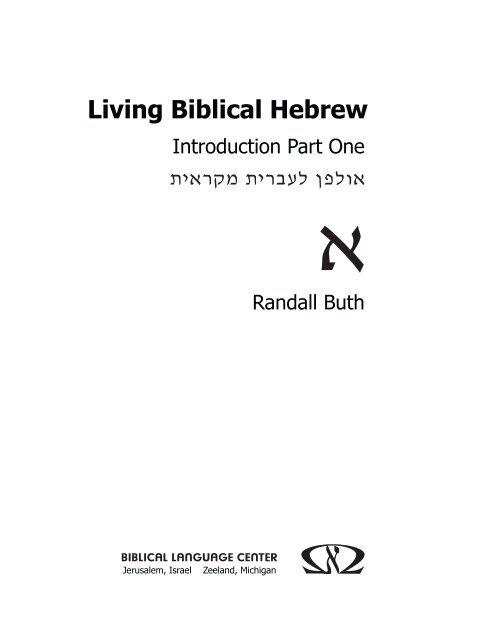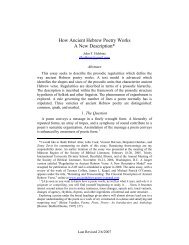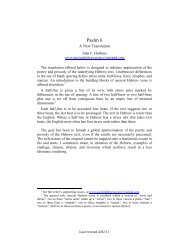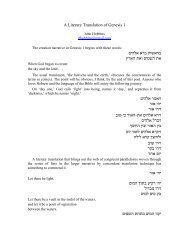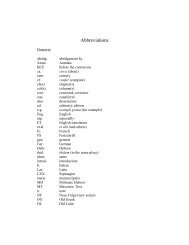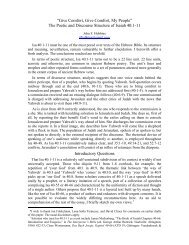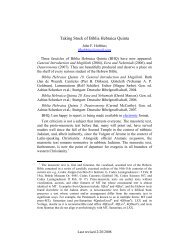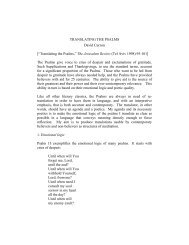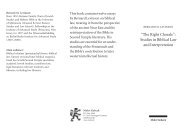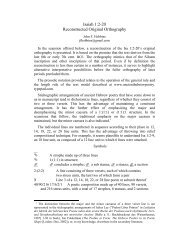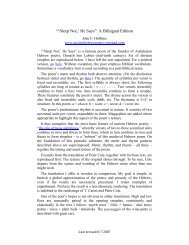Living Biblical Hebrew - Ancient Hebrew Poetry
Living Biblical Hebrew - Ancient Hebrew Poetry
Living Biblical Hebrew - Ancient Hebrew Poetry
You also want an ePaper? Increase the reach of your titles
YUMPU automatically turns print PDFs into web optimized ePapers that Google loves.
<strong>Living</strong> <strong>Biblical</strong> <strong>Hebrew</strong>Introduction Part OneRandall ButhJerusalem, Israel Zeeland, MichiganW
© 2006 Randall ButhAll rights reserved. No part of this publication may be reproduced, translated, stored ina retrieval system, or transmitted in any form or by any means, electronic, mechanical,photocopying, recording or otherwise, without prior written permission from the publisher.For information, address <strong>Biblical</strong> Language Center, POB 82340, Mevasseret Zion 90805, Israelor 55 East Roosevelt Rd., Zeeland, Michigan, 49464-1210, USA.Cover Artwork and all illustrations by Sharon AlleyDesign by Gary Lee Alley, Jr.Recorded voices are Randall Buth, Danny Kopp, and Shoshi Kvasnica.Recorded at Israel Vision Studios, Jerusalem, engineered by Josh Rawlings.Library of Congress Cataloging-in-Publication Data:Library of Congress Control Number: 2005904342ISBN 965-7352-00-2<strong>Living</strong> <strong>Biblical</strong> <strong>Hebrew</strong>Introduction Part OnePublished by <strong>Biblical</strong> Language Centerwww.biblicalulpan.orgPrinted in the United States of America.Distributed by EN-GEDI RESOURCE CENTERHolland, Michiganwww.en-gedi.org
To Margret
ContentsPrefaceAbout This CourseInstructions 11. Picture Lesson One 32. Picture Lesson Two 13Quiz: Lessons 1-2 223. Picture Lesson Three 254. Picture Lesson Four 35Quiz: Lessons 3-4 445. Picture Lesson Five 476. Picture Lesson Six 57Quiz: Lessons 5-6 667. Picture Lesson Seven 698. Picture Lesson Eight 79Quiz: Lessons 7-8 889. Picture Lesson Nine 9110. Picture Lesson Ten 101Quiz: Lessons 9-10 11011. Introduction to the <strong>Hebrew</strong> Alphabet 113Alphabet Lists 1-8 -114Notes on Spelling: Five Vowels, Dagesh, and Shva 119Alphabet Lists 9-16-122<strong>Hebrew</strong> Letter Names and Order 127Vowels and Other Marks 130
Contents Learning to Write the <strong>Hebrew</strong> Alphabet 132<strong>Hebrew</strong> Pronunciation 134Diagram of Mouth with Positions of Some <strong>Hebrew</strong> Sounds 136Dagesh, Syllables, Shva, and Accent 137Written Exercises 1: Dagesh 138Written Exercises 2: Shva 143Written Exercises 3: Syllables 14412. Reading Lessons 1-10 14713. A Preview of Some <strong>Hebrew</strong> Patterns 169Subject and Object Pronouns 169Some Verb Patterns for the Present Tense 171Some Verb Patterns for the Past Tense 174Sequential Future Endings 176Sequential Past Tense Prefixes 178Answer Keys 181Index to Words and Forms 187
PrefaceFor eighteen years I worked in Africa with Bible translation projects. The dedicated workers inthese projects brought a wealth of background to their task. Some translators desired to understand<strong>Hebrew</strong> but they needed to learn <strong>Hebrew</strong> quickly in order to use it in their translations. Others hadstudied <strong>Hebrew</strong> and Greek for many years and knew that something was missing in their biblicallanguage training. As multilinguals they could compare their progress with languages that they hadlearned, like French, English, Arabic or German. They recognized the difference between their easeof use of these languages versus the biblical languages. Working with these translators made meaware of the need for better learning materials for biblical <strong>Hebrew</strong> and Koine Greek.What works for people when learning languages? What hinders people? What helps the learnerto rise to the highest levels and what restricts students to lower plateaus? What increases learningefficiency, speed and retention?Fortunately, language teachers and theorists have been working on these questions in manylanguages and situations. Effective, simple techniques have been discovered. Harry Winitz createdand developed The Learnables picture series for modern languages. James Asher made abreakthrough with his Total Physical Response method, which we use in our live summer classes.Stephen Krashen has explained factors like comprehensible input that contribute to naturallanguage acquisition. Even the army method of the US State Department has contributed helpfultechniques. Experienced language learners and Bible translators intuitively recognize when amethod works. A grammar book is not an end all for language learning. People want to feel thetexture of a narrative or of a poem—they want to have a sense of where they are in a text and howto work from within a language.In response to these needs, we began developing new biblical language materials in 1996.During semester classes and six-week summer courses in Jerusalem, we have tested and refined the<strong>Hebrew</strong> materials with students from all continents. Sharon, my daughter, began to help withteaching early on and provided important feedback for development. Another joy has beenwatching Aaron Hornkohl grow from a student in the summer of 1999 to an effective teacher forthis program in 2001. Another student from 1999, Heidi Scherer, has advanced to where we speakin <strong>Hebrew</strong> while discussing the <strong>Hebrew</strong> Bible. She currently works on a translation project in WestAfrica. Another <strong>Living</strong> <strong>Biblical</strong> <strong>Hebrew</strong> milestone came in the fall of 2002 in Jos, Nigeria, whenSharon, her husband Gary Alley, and I ran a six-week course for twenty Bible translators. We had alot of fun acting out and playing in biblical <strong>Hebrew</strong> during the classes. More importantly, thestudents learned biblical <strong>Hebrew</strong>. They sensed that the language was being grafted inside them.Several have helped in practical ways to see these volumes move toward publication. Ken andLenore Mullican of ha-Kesher, John Ward, the Jerusalem Cornerstone Foundation, and especiallythe staff of En-Gedi, Bruce and Mary Okkema and Lois Tverberg.The people who have helped and contributed to the success of this program are innumerable.First of all, the colleagues in translation projects over the past two decades have all made lastingcontributions to my own understanding of how human languages work. The learning continues.Two organizations in particular have contributed to this background, the Summer Institute ofLinguistics and the United Bible Societies. The numbers of individuals with significant input are fartoo many to name in this preface, but I would like to name a few to put a human face on theinstitutions. John Anderson, Jon Arenson, Katy Barnwell, John Beekman, John and Pam Bendor-Samuel, Julie Bentinck, Dick Bergman, Loren Bliese, Reinier du Blois, Joan Bomberger, Rick
Preface Brown, John Ellington, Carl Follingstad, Leoma Gilley, Ken Gregorson, Ernst-August Gutt, Ralphand Harriet Hill, Margaret Hill, John and Pam Hollman, Ted Hope, Rob Koops, Eileen Kilpatrick,Hanni Kuhn, Krijn van der Jagt, Dorothea Jeffries, Iver Larson, Stephen Levinson, RobertLongacre, Isaac Madugu, Bill Merrifield, Christo van der Merwe, Cynthia Miller, Aloo Mojola,Phil Noss, Willis Ott, Murray Salisbury, Doug Sampson, Martin and Helga Schroeder, Don Slager,Wanda Pace-Davies, Mona Perrin, Andrew and Janet Persson, Ray Pritz, Peter Renju, MikreSelassie, Ronnie and Margret Sims, Jan Sterk, Phil Stine, Paul Tucker, Aaron Uche, Roger VanOtterloo, Andy Warren, Dick Watson, Tim Wilt, Lynell Zogbo, and the list could go on. Mysincere thanks extend to all of them and their help has certainly been more than I have been able toacknowledge.In Jerusalem, Halvor and Miriam Ronning have supported this language program through theHome for Bible Translators. These biblical <strong>Hebrew</strong> materials have grown out of their program.David Bivin has always been an encouragement to try to get the materials as tight and efficient aspossible. He has freely shared his experience of teaching English and modern <strong>Hebrew</strong> as secondlanguages. My family has contributed greatly providing the haven that this work has needed. Manylong nights at the computer have been pardoned. They have all contributed to the typing, editing,and proofing of this text. They, too, share in some of the joy when a student begins to read the<strong>Hebrew</strong> Bible. My daughters, Sharon and Rachel, have helped immensely with teaching the courseand editing the materials. My son, Yony, during visits to Israel has also contributed more than theselines can offer as thanks. Sharon has also illustrated the pictures for <strong>Living</strong> <strong>Biblical</strong> <strong>Hebrew</strong>,Introduction Part One and Two. Gary Alley has especially helped me to get the manuscript intomore readable shape, though the final deficiencies are fully my own.My wife, Margret, has supported and upheld this project as the embodiment of the Proverbs 31woman. This is dedicated to her, my noble woman, . — Randall ButhMevasseret Zion2 August 2006Our granddaughter Shaya’s first birthday " '
About This CourseWelcome to <strong>Living</strong> <strong>Biblical</strong> <strong>Hebrew</strong>, a project to present optimal learning materials for thosewho would want to learn <strong>Hebrew</strong> up to the highest levels of language control. Extensive recordingsenhance learning through listening, which language theorists see as vital for true acquisition. All ofthe material—recordings, drills and readings are in biblical <strong>Hebrew</strong>.<strong>Living</strong> <strong>Biblical</strong> <strong>Hebrew</strong>, Introduction Part One, opens the world of biblical <strong>Hebrew</strong>. Beginnersand returning readers will enjoy the 1000 illustrations that are described in <strong>Hebrew</strong> on three audioCDs. Reading, writing and common grammatical forms are introduced in Part One.<strong>Living</strong> <strong>Biblical</strong> <strong>Hebrew</strong>, Introduction Part Two, continues from Part One and comes with elevenaudio CDs. Part Two covers the grammatical structures of biblical <strong>Hebrew</strong> through dialogues,drills, notes and annotated readings, focusing on the book of Jonah. Part Two offers two tracks oflearning. Track one is the basic course with the main lessons and their recordings. This trackallows all educational levels beyond primary school to learn the language fully. The second trackrefers to the linguistically sophisticated footnotes that augment a first year university course of thehighest standard.<strong>Living</strong> <strong>Biblical</strong> <strong>Hebrew</strong>, Selected Readings with 500 Friends, comes with one audio CD. Itcontinues a student’s development in biblical <strong>Hebrew</strong>. It is especially suitable for students afterthey have completed Part Two. Two Israeli radio announcers read biblical selections at a relaxedspeed. The contents include: Genesis 22, Genesis 1:1-2.3, Exodus 19-20, the complete book ofRuth, Psalms 8, 23, 150, Proverbs 3:1-8, and the shma (Dt 6:4-9).The <strong>Biblical</strong> Language Center offers a live biblical <strong>Hebrew</strong> immersion course every summer inIsrael. Visit www.biblicalulpan.org for more details.
About This Course Frequently Asked QuestionsIs this course different? If so, what is different about this course?This course is unique for biblical <strong>Hebrew</strong>. The student starts learning the language like achild, in <strong>Hebrew</strong> and not via a second language. A new way of thinking and learning is openedup for a student. This is an experience that cannot be duplicated by reading an English bookabout biblical <strong>Hebrew</strong>. This learning experience is essential for any student who wants to reallyknow biblical <strong>Hebrew</strong>. It lays a foundation for internalizing the language and provides betterlong-term efficiency.Is this course really biblical <strong>Hebrew</strong>?Yes, absolutely. All words in the lessons are biblical <strong>Hebrew</strong> and are used in the syntaxpatterns of biblical <strong>Hebrew</strong>.If my goal is to read biblical <strong>Hebrew</strong>, why should I study a course with so many voicerecordings?Because it is more efficient. You will learn significantly more words and structures in lesstime and with longer retention than with grammar/translation methods. You begin to learn thelanguage through listening comprehension and monolingual immersion. You will be able to readmore material per study hour, and more easily. It is also fun, as the student will soon discover.Listening is essential for profound language learning because that is the way human beingslearn and store their first language. While it is true that massive and extensive reading is the bestway to complete advanced language learning, such reading is most efficiently accomplishedwhen it rests on a foundation that has been developed through listening comprehension. For moredetails see the technical notes at the end of this section.Will I understand everything in these recordings with the pictures?Hopefully not! An important aspect of successful language learning is teaching the studenthow to guess and understand new situations. The student needs to learn to deal with the newlanguage directly. This develops a feel for the language. It is important for successful languagelearning and long-term retention that a student learns to relate to the new language as itself andnot as a paired extension of some other language. Successful modern language programs makeuse of these principles around the world. This is currently the only biblical <strong>Hebrew</strong> course thatuses and develops such a process, which makes it such a must experience for students of biblical<strong>Hebrew</strong>.What kind of pronunciation is used?An oriental Israeli pronunciation is used in this course. This provides a standard that shouldbe understandable anywhere in the world. Israelis appreciate this as a pleasing dialect for readingbiblical <strong>Hebrew</strong>. It is also the official standard for Israeli radio.Specifics for biblical <strong>Hebrew</strong> teachers: the five vowel sefardic system is used; both ayin andet are pronounced as true pharyngeal fricatives; the Israeli uvular resh is used; the consonants
About This Courseb~v, k~x, p~f change pronunciation; g, d, t remain constant; ts is used for tsadi [s with retractedtongue root], while tav/tet and kaf/qof are the same.How much <strong>Hebrew</strong> does one learn in the picture volume?The pictures in Part One introduce a student to about 700 different forms in varying syntacticcontexts based on 250 different vocabulary items. In addition, a student learns the alphabet andhow to spell the forms. This is accomplished in approximately 25–50 study hours. In context,students recognize and understand 80-95% of the material at this stage of learning.At the end of Part Two, students are able to read the book of Jonah with understanding.Because of the built-in repetition, exceptional students have been able to read these books outloud and correctly from unvocalized texts. Part Two requires 120-240 study hours.How does this course relate to modern <strong>Hebrew</strong>?First of all, this course is sufficient in itself and does not depend on any previous study of eithermodern <strong>Hebrew</strong> or biblical <strong>Hebrew</strong>.Additionally, this course harmonizes with modern <strong>Hebrew</strong> programs. A person may profitablystudy modern <strong>Hebrew</strong> concurrently with, after, or even before this course.The fluency, listening and reading skills that are developed in this course immediatelyreinforce the related skills in modern <strong>Hebrew</strong> because of the special way in which this biblical<strong>Hebrew</strong> course is taught. This course will make a direct and positive contribution to anyone whowishes to continue their <strong>Hebrew</strong> studies in any of the dialects.When does one learn grammar and syntax?Immediately from picture lesson one the student begins to learn grammar patterns and syntax,but without discussion. Learning grammar takes place directly in context. After the picturelessons and learning the alphabet, students should slowly study and observe the changes in thewords in the reading lessons.Discussions about grammar and syntax have a preview section at the end of Part One and theybegin systematically in Part Two. All the chapters of Part Two contain grammar notesinterspersed with the drills and annotated readings. By the end of the second part, the basic<strong>Biblical</strong> grammar forms and irregularities are summarized.An additional advantage of this course is that the notes and written assignments develop asensitivity for the literary features, style, and textlinguistics.The pictures in Part One begin to lay a foundation for later analytical grammar in the sameway that primer paint prepares for finishing paint. As with a quality paint job, the student isencouraged to follow directions and the natural learning sequence of this program.What about people who have already started learning biblical <strong>Hebrew</strong> or already read it, is<strong>Living</strong> <strong>Biblical</strong> <strong>Hebrew</strong> for them, too?Yes, these recordings and pictures will help anyone who has never had the experience oflearning <strong>Hebrew</strong> directly through listening. It will be a new experience and a new kind oflearning, whether someone has been reading biblical <strong>Hebrew</strong> for one year or seven years.
About This Course Technical Notes for <strong>Biblical</strong> <strong>Hebrew</strong> TeachersThe general methodology for the pictures in <strong>Living</strong> <strong>Biblical</strong> <strong>Hebrew</strong>, Introduction Part Onewas developed by Harris Winitz and can be seen most fully in the course that he has publishedfor German. Harris Winitz, The Learnables, 8 Books (International Linguistics Corporation,3505 East Red Bridge Road, Kansas City, Missouri 64137 USA). He has also produced courseswith the same picture books for Spanish, English, French, Modern <strong>Hebrew</strong>, Chinese, Czech,Russian and Japanese.This approach to language learning fits within a framework called listening comprehensiontheory, which is within the communicative approaches to language acquisition. Theoreticaldiscussions and testing of these approaches for reading and listening can be seen in HarrisWinitz, editor, The Comprehension Approach to Foreign Language Instruction (Rowley,Massashusetts and London: Newbury House Publishers, 1981). These have been paralleled instudies of Stephen Krashen “Natural Approach” and James Asher “Total Physical Response,”among others.Teachers will notice a high number of participles in the picture series of Part One. Thisreflects the best biblical <strong>Hebrew</strong> and was the most basic way that people talked about the actualpresent in biblical times. Cf. Gen 13:15, Jer. 1:11. The prefix tense that some books have taughtas a present tense was the polite way to ask questions in the present and usually referred tohabitual actions or volitional actions when classified as present. Cf. the dialogue in Genesis37:15-16 “What would you be looking for?” [prefix tense for polite question] “I’m looking formy brothers.” [participle for actual present] For further discussion on the participle, nominalclauses and the nuances of their word orders, see Randall Buth, “Word Order in the VerblessClause: A Generative-Functional Approach,” in Cynthia Miller, ed., The Verbless Clause in<strong>Biblical</strong> <strong>Hebrew</strong> (Winona Lake, Indiana: Eisenbraun’s, 1999) 79-108.Some teachers may also notice that words like bayit/vayit and bore a /vore a do notconsistently reflect whether or not a vowel precedes the word. The <strong>Hebrew</strong> Bible shows the sameinconsistency, since this alternation only operates within very short phrase units. A biblical writerwould be expected to approve the following mix: / va/baim in hu va, veha-naar vehanaarabaim.Finally, even the vav ha-hippux structure makes its way into this introductory picture series. Itis a delightful illustration of how children would have learned the structure three thousand yearsago.
InstructionsWelcome to a doorway into the world of <strong>Biblical</strong> <strong>Hebrew</strong>. This course will help you begin tothink in and with <strong>Biblical</strong> <strong>Hebrew</strong>! Each picture lesson has 100 pictures. Every picture is numbered.The number will be spoken before the words that describe the picture. The numbers will proceedfrom 1 to 10 and then repeat from 1-10 until all 100 pictures have been presented.Please listen to the recording (CD 1, Track 2) while the numbers listed below are read in biblical<strong>Hebrew</strong>. They will be repeated twice and then read in series twice. Please listen to the numberswithout trying to pronounce them yourself. By the end of the first two picture lessons the repetitionin the lessons will be sufficient for the student to recognize the numbers one through ten.1 12 2 1 2 1 23 3 1 2 3 1 2 34 4 1 2 3 4 1 2 3 45 5 1 2 3 4 5 1 2 3 4 56 6 1 2 3 4 5 6 1 2 3 4 5 67 7 1 2 3 4 5 6 7 1 2 3 4 5 6 78 8 1 2 3 4 5 6 7 8 1 2 3 4 5 6 7 89 9 1 2 3 4 5 6 7 8 9 1 2 3 4 5 6 7 8 910 10 1 2 3 4 5 6 7 8 9 10 1 2 3 4 5 6 7 8 9 101 2 3 4 5 6 7 8 9 10You may proceed to Picture Lesson One after reading the following instructions:1. Relax Look at each picture and listen to the recording.2. Do not repeat or mimic outloud what you hear. Just listen and enjoy the adventure of languagelearning. Most pictures will be immediately understandable. Some words and some details will onlybecome clear after several lessons.3. Listen to each lesson completely without stopping.4. Repeat a whole lesson at least two times with the pictures and then once without the pictures. Thegoal is to be able to understand 90% what is being described without needing a picture. Additionalreview listenings will help. Most students find four to eight listenings to be helpful and stimulating.It is preferable to delay reading until after lesson 10. It is important to open your ears and mind,understanding the language through your hearing, before beginning to read. Learning the alphabet isa different matter. The student may begin learning the alphabet at any time but should delay1
Instructions 2beginning the readings until all of the picture lessons have been completed through multiplelistenings.After every second lesson there will be a short quiz for you to check that you understand at least80% of the material. If you get 8 to 10 questions correct, you may proceed to the next lesson. Evenso, it is sometimes more satisfying to enjoy a review session than to rush ahead.Note for adult language learnersThis method will seem adventurous and fun most of the time. There will be many times whensomething new is introduced and you will only partially understand what is going on. This is part oflaying a good foundation for deeply learning a language. Simply accept that what you hear isappropriate for describing what you see. Focus on the jumble of new sound and do not try toassociate an English word. One picture or one scene is insufficient to grasp the new word anyway.Because of the pictures, you will be unconsciously learning a part of the meaning, even if you onlylearn which part at a later time. That is how you developed such a great grasp of your first language.You will notice that words are not always used where you might predict. You will also noticelittle changes taking place in some of the words. That is good. The adult learner wants toimmediately stop the learning and ask “why?” A child accepts the changes. As an adult you willneed to trust that the questions will be answered at the appropriate time. They will be. However,successful adult language learners know that the first answer to “why?” is “because that’s the waythey do it.”Something more important will be going on with these pictures than merely learning some wordsand structures in the new language. A foundation will be laid that will make further learning of thelanguage more efficient. You may think of it as laying down primer paint before coats of finishingpaint. These pictures and this method help to make the language sticky, so that it sticks to you andstays with you.In Part Two of this course you will encounter other methods of language learning, includingaudiolingual dialogues and more traditional annotated readings and grammar explanations. But letthose methods wait until you have started with this monolingual immersion through pictures. Even inPart Two it is important to spend more time with the recordings than with the explanations. Thisprogram can produce doubled efficiency, and more, in learning rates and retention.Note for those who have already begun learning <strong>Biblical</strong> <strong>Hebrew</strong> through reading.These pictures are important! Listen to them fully, at least the recommended number of times.Your whole brain will be more actively involved in the process. That is part of what will make iteasier to remember words and meanings a year from now, or longer. The relationships betweenwords and between words and various meanings will all be recorded and cross-referenced in a newway.The most important direction is “Relax!” Do not try to think about how the word might be spelledwhile listening. You will have all of the opportunities necessary for correctly learning the spellingand reading at the appropriate time. Meanwhile, these pictures will develop some direct wiring inyour head to facilate the proper storage of the language. Even those with advanced readingknowledge will benefit from this re-wiring process. You will begin to feel and experience a differentway of learning.
Picture Lesson 1 Recordings are on CD 1, Track 33216549873
1 42110543876110 (20)9
5Pictures 143276510 (30)98321
<strong>Hebrew</strong> Alphabet 120The short vowels were used when a syllable was unaccented and closed, i.e. in an unaccentedsyllable ending in a consonant, CVC [consonant-vowel-consonant]. An open syllable has aconsonant and vowel, without a closing consonant: CV [consonant-vowel]. An open syllable in<strong>Hebrew</strong> either has a long vowel or an accented short vowel.NOTE WELL: The symbols for the long a and the short o are the same. When the symbol [ ] isfound in a closed, unaccented syllable it is pronounced o. Stated another way, an o sound is writtenwith when it is unaccented and in a closed syllable. Due to the history of the language, the long a vowel is more common than the short o vowel.Dagesh and begedkefet lettersA dot called dagesh is used in consonants 4 for two functions.1. In general, the dagesh marked a lengthened consonant; it was pronounced momentarily longer.A lengthened consonant would function as a double consonant, one consonant closing a syllableand one consonant beginning the next syllable. Thus, hab-báyit, and hil-lél. In modern<strong>Hebrew</strong>, these lengthened consonants are not pronounced differently and they are notdistinguished on the recordings in this course. 5 Grammar books call this dagésh azáq “strongdagesh” or dagésh kaflán “doubling dagesh”.2. The dagesh is also used with a select group of consonants to distinguish a stop, a hardpronunciation, from a fricative, a soft pronunciation. The group of consonants is , , , , , .These consonants are often called by an acronym begedkefet or begadkefat. A Basic Rule:begedkefet letters are soft when following a vowel and they are written without dagesh. Whenfollowing a consonant they are hard, and written with dagesh. 6 This is an automatic process thatis not related to meaning. The dagesh makes a difference in pronounciation on three of theseconsonants today. Thus , , and with dagesh are pronounced as the stops b, k, p. On theother hand, , , and without dagesh are pronounced as soft fricatives v, x, f. (The symbol x islike German ch.) These three letters, , , and are the only begadkefat letters that have twopronunciations in Israeli <strong>Hebrew</strong>. 7 The remaining three consonants, , , (g, d, t), are always4 The dot in o and u are considered vowels and are not the dagesh in a consonant. There is also a dot ina final called mappiq, which marks a pronounced h and will be learned later.5 One verb pattern is built around a lengthened (doubled) consonant in the middle of the word, e.g., hillel ‘hepraised’, dilleg ‘he jumped’, dibber ‘he spoke’. These are now pronounced hi-lel, di-leg, di-ber.6 For grammatical analysis of words it is important to learn that begedkefet letters receive a dagesh wheneverbeginning a word of a new phrase or when following a closed syllable, i.e., when following a consonant, not avowel. Such a dagesh in a begadkefat letter does not represent a grammatical lengthening of the consonant, itonly affects allophonic spelling rules, half of which are pronounced today. Stated from the other direction,when a begadkefat consonant follows a vowel within a phrase it does not receive a hardening dagesh (evenacross word boundaries within a phrase), though it may receive a lengthening dagesh. For example, in ‘he will speak’, the is following a half-vowel, i.e., not a vowel-less consonant (see below under shva), anddoes not receive a dagesh. The is also following a vowel [ ] and might have been expected to be withoutdagesh since it is a begadkefat letter. However, this word has a lengthened consonant at this point so the has a lengthening dagesh and gets pronounced as a hard b in spite of following a vowel. Grammatically,yedab- is analyzed as a complex, closed syllable and -ber is a closed syllable. Practically, for those learningto speak, is like three syllables: ye-da-ber.7 In the times of the judges the begedkefet letters were probably all pronounced as stops, likeEnglish b,g,d,k,p,t. By the Second Temple period each of these stops had a corresponding fricativepronunciation when immediately following a vowel within a word or small phrase and when not lengthenedby the lengthening dagesh. The phonetic symbols for such fricatives are v, γ, δ, x, f, θ . In modern <strong>Hebrew</strong>,only three of these pairs are pronounced, /b~v/, /k~x/, and /p~f/. The remaining three consonants, (g,d, t), are always pronounced hard as stops, regardless of whether the hardening dagesh is present or written.
121<strong>Hebrew</strong> Alphabetpronounced hard as stops, regardless of whether the hardening dagesh is present or not. Thedagesh that is related to begedkefet letters is called dagesh qal “light dagesh” in grammar books.NOTE WELL: If a begedkefet letter follows a vowel within a word, and still has a dagesh, thenthat dagesh is the lengthening [doubling] dagesh, mentioned in point one. This will be drilledafter the alphabet has been learned. For more information on dagesh, see pages 137-138.ShvaThe symbol shva [ ] also has two functions 8 .1. The shva symbol is placed under a consonant that closes a syllable to mark the absence of avowel. In malkó, the ends the first syllable and receives a shva. 9 Notice, also, that the which follows, has received a dagesh, since it is a begadkefat letter which follows a consonantwithout a vowel. A shva that closes a syllable is normally written when it is within a word but byconvention it is not written at the end of a word. Two special cases, though, receive a written,word-final shva: a final kaf that has no vowel, e.g., ‘king’, and the feminine 2 nd personsingular verb ending as in dibbárt ‘you fs spoke’.2. Shva is also used at the beginning of complex syllables to mark a half-vowel. The vowel ispronounced like e , that is, or , but it may be slurred to the point of not being pronounced atall in rapid speech. These vocal shva half-vowels represent a placeholder from a vowel that hasdropped out of the word for various grammatical reasons or as a historical process from anearlier stage of the language. For example, davár means ‘word, thing’ and is usedindependently, while - devar- means ‘word of-’ ‘thing of-’, and is connected to a followingword. In this context the word reduces to one complex, grammatical syllable and the missingvowel of the original first syllable is represented by the shva half-vowel. Another example, meat ‘a little bit’ is a dictionary entry with a half-vowel for a word whose first vowel droppedout before becoming standardized in biblical <strong>Hebrew</strong>. These vocal half-vowels are called shvana in <strong>Hebrew</strong> ‘moving shva’. The shva in the name itself, , is a ‘moving shva’since it begins a syllable.NOTE WELL: The above explanations provide a beginning analysis of the writing system. Thestudent should be aware that being able to describe and explain the writing system is a differentmatter from learning to read and use the writing system. Full explanations may best be left foradvanced studies. Meanwhile, the student should continue to learn to read <strong>Hebrew</strong> by proceeding tothe next alphabet list!Thus, in Second Temple times and in the Massoretic <strong>Hebrew</strong> text, the word ‘door’ was pronounceddéleθ. Today, it is pronounced délet, and will be heard like that on the recordings. As a result, the modernpronunciation can be thought of as halfway between King David’s pronunciation and the Massoreticpronunciation, 3 out of 6.8 A third usage in conjunction with the low, short vowels will not be discussed since the symbols have not been presented yet. They are a variant of the second shva, the half-vowel, and they also lead to anirrelevant complication at this stage between the two kinds of shva.9 This kind of silent shva is called shva na in <strong>Hebrew</strong>, ‘resting shva’.
<strong>Hebrew</strong> Alphabet12210-Recordings are on CD 3, Track 139-Recordings are on CD 3, Track 12 = .1.2.3.4.5.6.7.8.9.10.11.12.13.14.15.16.17.18.19.20.21 = .1.2.3.4.5.6.7.8.9.10.11.12.13.14.15.16.17.18.19.20.21Use Answer KeyUse Answer Key
<strong>Hebrew</strong> Alphabet 134<strong>Hebrew</strong> PronunciationSo far in the course, the student has not been required to pronounce <strong>Hebrew</strong>. That will begin to changewith <strong>Living</strong> <strong>Biblical</strong> <strong>Hebrew</strong>, Introduction Part Two. Below are some guidelines for pronunciation. Thesenotes will help the student when trying to understand and appreciate many of the seemingly irregularsound changes that occur in <strong>Hebrew</strong> words.<strong>Hebrew</strong>, as a Semitic language, used the tongue-root to produce many of its sounds. Please study thethe mouth-throat diagram at the end of this pronunciation guide in order to know where the tongue-root islocated.The most conspicuous sounds are ayin and et. They are formed by retracting the tongue-roottowards the back of the pharyngeal cavity [throat, below uvula]. These two consonants are stillpronounced today in the Oriental Israeli pronunciation. ayin is voiced, et is voiceless.However, several consonants were also pronounced with a constricted tongue root, even though suchpronunciations are no longer used today. , , were actually just , , pronounced with the tonguerootretracted into a constricted pharynx at the same time. Today, and are pronounced the same, k.Also, and are pronounced the same, t . is distinguished from by using an affricate, ts . Today,the tongue-root is only retracted for the consonants ayin and et.As can be imagined, pronouncing sounds with the tongue in the mouth while simultaneouslyretracting the tongue-root into the pharynx can cause surrounding vowels to have a slightly differentsound. Many of the rules about how <strong>Hebrew</strong> words change their shapes are the result of this tongue-rootphenomenon. For example, the guttural consonants , , , have a preference for a vowels . Thispreference for a is especially strong in ayin and et. These two consonants require so much energy toproduce, relatively speaking, that they also developed the helping vowels at the end of words like .Such vowels are not counted in the grammar as additional syllables but are considered part of the finalconsonant. This may be more easily understood from the history of the language. A Second Temple namelike did not have a final a vowel, only the consonant ayin. However, when pronouncing the ayin,something close to an a was heard, so it was added to the writing system when the vowels were recordedat the end of the first millenium CE.Pronunciation Tips 261. Use ε/e as a rest sound and as the sound when pausing to think.This is the sound that Israelis use and will naturally provide the correct starting point for the tonguewhen executing speech. Note: ‘uh’ or ‘um’ is distinctly English and non-<strong>Hebrew</strong>.2. Vowels should be clear Spanish i, e, a, o, u.There is no <strong>Hebrew</strong> sound like ι in English ‘bit’ and ‘hit’. <strong>Hebrew</strong> only has the sound of i in English‘beet’, ‘heat’. There are no y or w vowel-glides to the vowel sounds e, o. Those vowels must bepracticed to be clean, i.e., without the characteristic English tightening at the end of similar Englishvowels. Also, u is always like English ‘boot’ and never like English ‘put’.26 An Israeli pronunciation will give the student the easiest access into further <strong>Hebrew</strong> studies. This includesworking with other dialects like the <strong>Hebrew</strong> of the Dead Sea Scrolls, mishnaic <strong>Hebrew</strong> and Israeli scholarlyliterature. An Israeli pronunciation also serves as a standard when meeting people from around the world who comefrom many different linguistic backgrounds.
135<strong>Hebrew</strong> Alphabet3. Consonants made with the tip of the tongue, e.g., t, d, n, l.T, d, n, l are regularly made with the tongue-tip slightly more forward than in English, against the backof the teeth. <strong>Hebrew</strong> does not use interdental sounds, as in English ‘the’, so the tongue is freer to moveforward than in English, without ambiguity. Especially contrastive for lamed is the English ullsound. English “pull” has the back of the tongue bunched/tightened. <strong>Hebrew</strong> does not use that l buthas a relaxed l, like the “ll” in English “pill”.4. <strong>Hebrew</strong> p, t, k are spoken with less breath following the consonant.P, t, k are only moderately aspirated in comparison to English, yet stronger than Spanish. The <strong>Hebrew</strong>t is half-way between the t in English ‘top’ and ‘stop’. Hold your hand to your lips to feel thisdifference.5. resh is commonly made with a uvular trill at the beginning of a syllable.At the end of a syllable the trill is stopped or swallowed and often not recognized by English-speakingstudents. NOTE WELL: a uvular trill is not like a Spanish tongue-tip trill and it is even farther back inthe throat than the French velar-fricative r.It often takes one to two months of practice for this sound to become relatively smooth for alanguage learner. If, after two months, the student simply cannot produce the sound, then aSpanish/Arabic tongue-tip trill can be used as a substitute. Practice gargling before giving up! Yourmouth probably can do a gargle/trill, even if it feels strange or ridiculous at first.6. Both ayin and et are made in the pharynx, not in the mouth. Both ayin and et are correctlyproduced by retracting the root of the tongue in an attempt to constrict the throat channel well belowthe uvula. See the mouth diagram on the following page. The et is produced without simultaneousvocal chord vibration, i.e., without voicing, in the same way that p, t, k are voiceless. ayin isproduced with simultaneous voicing, like b, d, g. Notice that these sounds are quite distinctive from,and do not equal, the so-called German ch in ‘achtung’, or the glottal stop in ‘oh-oh’. That German chsound is made at the same point in the mouth as a k and is not a pharyngeal sound at all. It is a softkaph, kaf rafa, as in . The pharyngeal fricative sounds, ayin and et, are minority sounds in Israeland used by Oriental Jews. They are official for Voice of Israel announcers and are regularly heard onradio news announcements.7. In general, the quality of speech is more open and hollow in Israeli <strong>Hebrew</strong>.This last quality will sometimes give the impression of being slightly lower on a musical scale. Thebest learning technique is to listen carefully and practice mimicking. It can effectively be practiced atthe same time as practicing tip 1 above, ε.A person cannot practice all of the above at once. Take one at a time, work on it for a day or twowhile memorizing dialogues in <strong>Living</strong> <strong>Biblical</strong> <strong>Hebrew</strong>, Introduction Part Two. Then move on to anotheritem. Review all items later. A significant improvement in accent should become noticeable after acouple of months.
Index to Words and FormsThis is an alphabetical list of all the words from Picture Lessons One through Ten. The variousforms of each word are collected together under their most basic form. Usually the most basic form isa singular noun or a past tense verb in the third person, masculine singular. The number after everyword form is the chapter number for the first occurrence of that form. An approximate English glossis also provided for basic words.10 6 6 10 10 woman1 1 1 1 7 8 7 7 9 3 Assyria10 10 that, which9 you (ms)7 shovel, hoe6 6 6 9 9 6 (definite object marker)1 1 7 7 7 3 4 3 4 5 you (fs)8 eat1 4 8 1 4 3 3 farmer6 6 9 6 6 6 to3 6 these(see )mother7 7 7 say7 5 9 we9 I7 7 four6 6 7 7 long8 8 land, earth10 father7 7 7 stone6 6 7 7 7 Edom10 love7 7 one6 4 hold, grab2 2 after3 2 another4 there isn't, is not3 8 9 6 7 9 ?where9 man1 1 4 8 3 3 187
188Index-in, with43come44456104 9 9well55morning10young man66between55egg132111house115 10 10 10 10cry, weep4son777build7777777877owner, husband78harvest grapes556look for, request75 8989iron1010run away, flee9899meat, flesh11daughter77 7 7877high, tall10big61.21610fence, wall575710Galilee101010also, too54camel339559vine585566winepress5fish1128south10step on, trample67666way, road88-is it? (question marker))(?7-the()1()1()7


